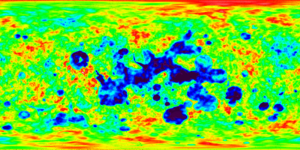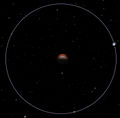Difference between revisions of "Duna/pl"
| Line 48: | Line 48: | ||
| | | | ||
[[File:Atmosphere_kerbin_duna.png|thumb|right|Porównanie atmosfery Duny i Kerbinu]] | [[File:Atmosphere_kerbin_duna.png|thumb|right|Porównanie atmosfery Duny i Kerbinu]] | ||
| + | Atmosfera Duny rozpoczyna się na wysokości 14,446 m. Jej gęstość stanowi tylko 20% gęstości atmosfery Kerbinu na wysokości 0 m, i staje się procentowo jeszcze rzadsza na wyższych pułapach. | ||
| − | + | Podobnie jak inne atmosfery, atmosfera Duny zanika wykładniczo wraz ze wzrostem wysokości (współczynnik wysokości 3000 m). Generalnie, ciśnienie atmosferyczne na Dunie na wysokości wyrażonej w metrach to:<ref>A [[LV-N Atomic Rocket Engine|nuclear engine]] ma impuls właściwy 220 w 1 atm, 800 w próżni, oraz podane wartości na Dunie: | |
| − | |||
| − | |||
{| | {| | ||
| − | | | + | | wysokość (m) || 2 || 100 || 300 || 500 || 1460 || 2420 || 3000 || 4272 || 5000 || 10000 |
|- | |- | ||
| − | | | + | | impuls właściwy || 684.1 || 687.8 || 695.1 || 701.8 || 728.7 || 748.2 || 757.3 || 772.1 || 778.1 || 795.9 |
|}</ref> | |}</ref> | ||
Revision as of 15:42, 9 December 2012
Duna Jest czwartą planetą systemu Kerbol. Jest odpowiednikiem Marsa, ma barwę czerwoną, i posiada czapy lodowe na biegunach. Posiada jednego naturalnego satelitę księżyc Ike. Ze względu na wzajemną bliskość, Ike i Duna znajdują się w synchronicznej rotacji.
Contents
Topografia
|
Duna jest planetą bogatą w żelazo, z dużymi wahaniami w wysokości terenu, co znacznie utrudnia znalezienie dobrego miejsca do lądowania. Lądowanie utrudnia również rzadka atmosfera która nie daje możliwości znacznego hamowania atmosferycznego (spadochron). Zalecane jest znaczne zwolnienie przed wejściem w atmosfere. a powierzchni w kilku miejscach znajdują się tzw. "Morza" dające się rozpoznać dzięki ciemniejszemu zabarwieniu powierzchni na wysokości dokładnie 0 m. TSą one najlepszymi terenami do lądowania dzięki niskiemu położeniu pozwalającej na efektywne hamowanie atmosferyczne. Oba bieguny posiadają bardzo duże pokrywy lodowe - efekt bardzo rzadkiej atmosfery. Centralne regiony układają się w kształt przypominający Europę. Powierzchnia Duny zawiera sporo easter eggów |
Atmosfera
|
Atmosfera Duny rozpoczyna się na wysokości 14,446 m. Jej gęstość stanowi tylko 20% gęstości atmosfery Kerbinu na wysokości 0 m, i staje się procentowo jeszcze rzadsza na wyższych pułapach. Podobnie jak inne atmosfery, atmosfera Duny zanika wykładniczo wraz ze wzrostem wysokości (współczynnik wysokości 3000 m). Generalnie, ciśnienie atmosferyczne na Dunie na wysokości wyrażonej w metrach to:[1] Parachutes work at lower efficiency than on Kerbin, making powered descent necessary when landing from orbit (unless your craft is a glider or just a pod with a parachute). The following table gives terminal velocities at different Duna altitudes. These are also the velocities at which a ship should travel for a fuel-optimal ascent from Duna, given the game's model of atmospheric drag.[2]
|
Orbital Statistics
The geosynchronous orbit of Duna is at an altitude of 0,00 m above Duna. The speed of the satellite is 0,00 m/s and it has an orbital period resonating with 1 Duna day (18.2 hours or 65517.859375 seconds). However, this orbit is not possible since it intersects with Ike's SOI.
For a semi-synchronous orbit of ½ Duna day (9.025 hours or 32490 seconds) an orbit of 0,00 m above Duna is needed with a velocity of 0,00 m/s.
Reference Frames
| Warp | 5x, 10x | 50x | 100x | 1000x | 10,000x | 100,000x |
| Minimum Altitude | above atmosphere | 60 km | 100 km | 300 km | 600 km | 800 km |
Gallery
- Duna projection.png
A false color Mercator projection of Duna's surface using MapSat.
Changes
- Initial Release
Trivia
- On the surface of Duna, there is a large monument carved in the likeness of a Kerbin face, alluding to the infamous "Face of Mars" discovered in the Cydonia Mensae region of Mars during the 1970's.
- Duna's name may be either a reference to its desert landscape or a shout-out to the Frank Herbert novel Dune.
- One anomalous feature on Duna is a small, pyramid-like hill emitting an SSTV signal. When decrypted, it shows a diagram-like image of three figures standing next to the hill itself, implying that Duna was once inhabited.
Notes
- ↑ A nuclear engine ma impuls właściwy 220 w 1 atm, 800 w próżni, oraz podane wartości na Dunie:
wysokość (m) 2 100 300 500 1460 2420 3000 4272 5000 10000 impuls właściwy 684.1 687.8 695.1 701.8 728.7 748.2 757.3 772.1 778.1 795.9 - ↑ http://forum.kerbalspaceprogram.com/showthread.php/6664-Mini-challenge-max-altitude-with-this-supplied-spacecraft?p=100912&viewfull=1#post100912







